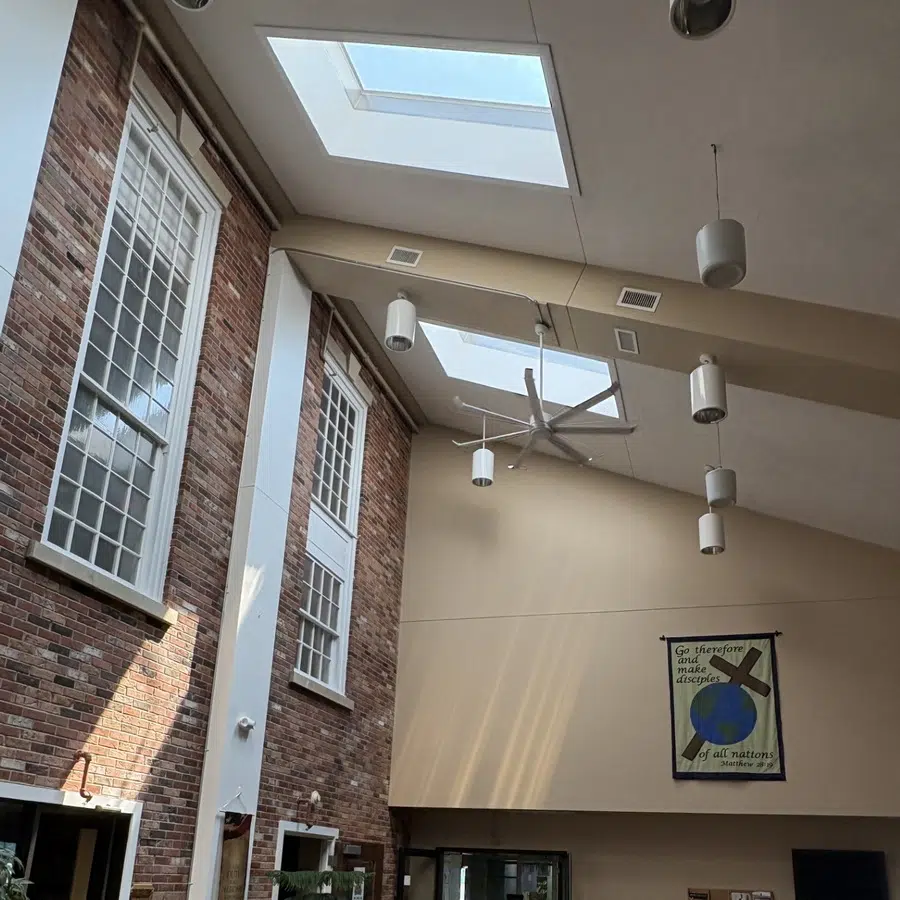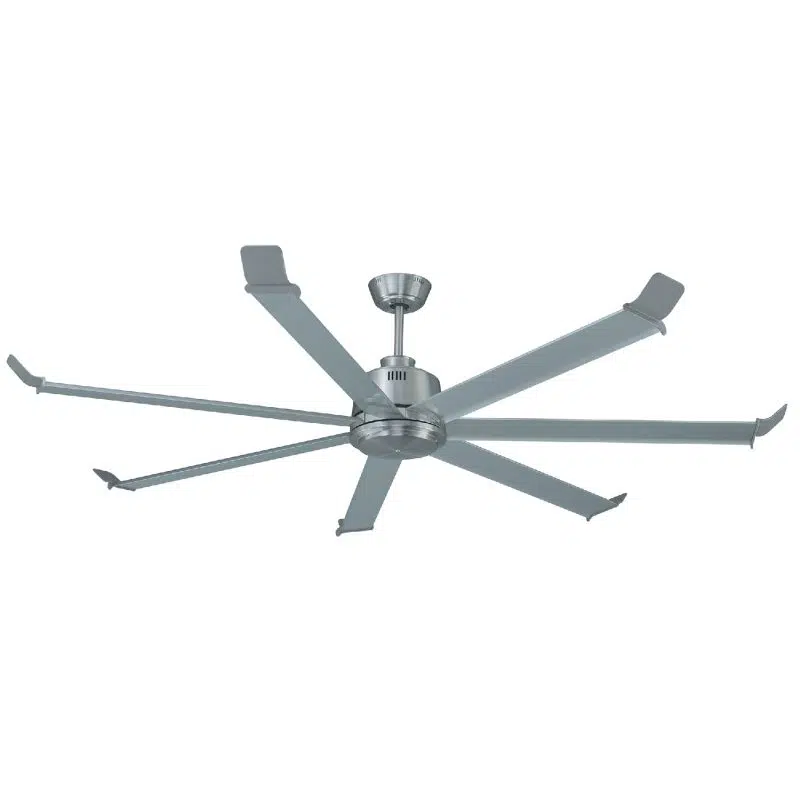Showing all 2 results
- SKU:LLS-CM-FAN-68IN-8B-MBK | Web ID:2296Availability:25 In StockShips 2-3 Days
- Diameter: 68 in
- Speed: 4
- Color: Matte Black
- Blade Material: Aluminum
- Controller: Yes
- Blades: 8
- Reverable: Yes
- Fan CFM: High: 7,024 CFM | Low: 2,730 CFM
- RPM: High: 105 Low: 42
- Fan Weight: 30.5 lbs
- Motor Size: 188 x 25 mm
- IP Rating: ETLus listed for wet location
- Downrod: 4 inch included | 2ft sold separately
- Voltage: 120V
- Warranty: Motor: Limited Lifetime | Non-Electrical: 1 years
Starting At$404.65 - SKU:LLS-CM-FAN-80IN-7B-P | Web ID:2298Availability:25 In StockShips 2-3 Days
- Diameter: 80 in
- Speed: 5
- Color: Pewter
- Blade Material: Aluminum
- Controller: Yes
- Blades: 7
- Reverable: Yes
- Fan CFM: High: 11,274 CFM | Low: 6,707 CFM
- RPM: High 101 Low 61
- Fan Weight: 35.3 lbs
- Motor Size: 180 x 17 mm
- IP Rating: UL Wet locations
- Downrod: 8 inch and 2 foot included
- Voltage: 120V
- Minimum Mounting Height: 10 Feet
- Minimum Horizontal Clearance: 30 Inches
- Warranty: Motor: Limited Lifetime | Non-Electrical: 1 Year years
Starting At$534.00
What are Commercial Ceiling Fans?
Commercial ceiling fans represent heavy-duty air circulation solutions designed for demanding business environments, spanning diameters from 52 to 80 inches with robust 120V motor systems. Unlike residential models, these industrial-grade units feature 6 to 8 aerodynamic blades and variable-speed controls that deliver substantial airflow across expansive spaces. We typically recommend these fans for facilities with ceiling heights between 10 and 30 feet, where traditional HVAC systems struggle with efficient air distribution.
The reversible motor capability transforms these fans into year-round climate management tools. During summer months, the standard counterclockwise rotation creates downdraft airflow that produces a cooling wind-chill effect. Winter operation reverses to clockwise rotation, drawing cool air upward while forcing warm stratified air down from ceiling level. Most commercial models consume between 75-150 watts while moving thousands of cubic feet of air per minute, making them remarkably energy-efficient compared to traditional HVAC solutions.
What are the Benefits of Using Commercial Ceiling Fans?
- Create a more comfortable environment - Large-diameter fans eliminate dead air zones and temperature variations that plague high-ceiling facilities. The consistent air movement prevents hot spots near equipment and cold drafts in entry areas, creating uniform comfort conditions across the entire floor space.
- Energy cost savings - Strategic fan placement reduces HVAC operating expenses by up to 40 percent annually through improved thermal efficiency. Enhanced air circulation allows facility managers to adjust thermostats 3-4 degrees in either direction while maintaining occupant comfort, translating to significant utility bill reductions.
- Provide summer cooling - The wind-chill effect generated by commercial fans makes occupants feel 6-8 degrees cooler without any change in actual air temperature. This physiological cooling response reduces reliance on expensive air conditioning during peak summer demand when utility rates are highest.
- In cooler areas, fans use warmer air near the ceiling and push the warm air down - Reverse motor operation eliminates thermal stratification by pulling heated air down from ceiling level where it naturally accumulates. This destratification process can recover 10-30% of lost heating energy in warehouses, manufacturing facilities, and other high-ceiling applications.

What are the Best Applications for Commercial Ceiling Fans?
Commercial ceiling fans are most commonly utilized by commercial businesses that operate in large, open-space facilities. These facilities can be too large to regulate ambient temperatures with standard HVAC systems and require a more efficient and practical solution. Here are some of the most common applications of commercial ceiling fans.
Commercial Fan Applications and Installation Considerations
Manufacturing facilities, warehouses, retail spaces, gymnasiums, and worship centers represent the primary applications where we install commercial ceiling fans. Each environment requires specific blade configurations and mounting approaches based on ceiling height, occupancy patterns, and existing HVAC infrastructure. For spaces with 12 to 16 foot ceilings, we recommend 52 to 60 inch models with down-rod mounting, while facilities with 20+ foot ceilings benefit from 70 to 80 inch fans with extended down-rod systems.
Installation planning involves electrical load calculations, structural mounting assessments, and airflow pattern analysis to optimize fan placement. Most commercial units require dedicated 20-amp circuits and reinforced ceiling junction boxes rated for dynamic loads. We often incorporate wall-mounted speed controls and programmable timers to automate seasonal operation changes and integrate with existing building management systems.
Motor Performance and Speed Control Options
Commercial-grade motors deliver variable airflow rates ranging from gentle circulation to powerful downdraft cooling based on operational requirements. Multi-speed controllers provide 3-6 discrete speed settings plus reversible operation for seasonal adaptability.
The permanent split capacitor motors used in quality commercial fans operate efficiently across all speed ranges while maintaining quiet operation below 35 decibels at normal speeds. Motor warranties typically extend 10-15 years for commercial applications, reflecting the robust construction required for continuous-duty operation in demanding environments.
Blade Design and Airflow Efficiency
Aerodynamic blade profiles optimize air movement while minimizing motor load and operational noise. Six-blade configurations provide smooth, quiet operation ideal for office environments and retail spaces, while 8-blade models maximize airflow volume for industrial applications. Blade materials range from moisture-resistant composites for humid environments to powder-coated aluminum for durability in harsh conditions.
Proper blade pitch angles between 12-15 degrees ensure optimal air movement without excessive motor strain. We calculate airflow requirements based on room volume and occupancy to recommend appropriate fan sizing and blade configurations that deliver effective air circulation without creating uncomfortable drafts or excessive noise levels.
Safety and Performance Certifications
All our fixtures carry essential certifications including UL Listed and ETL Listed approvals. These certifications ensure safety, performance, and energy efficiency.
Warranty and Warranty Support
All our fans come with at least a 5-year warranty, and all warranty support is based in the USA. We take customer support seriously, and helping you with a warranty claim is important to us. Our experienced support team understands the importance of keeping your lighting operational and will work quickly to resolve any warranty issues.
Ceiling Fans for Commercial Applications Frequently Asked Questions
What Size Commercial Ceiling Fan Do I Need for My Facility?
For facilities with 12-16 foot ceilings, select 52-60 inch fans with standard down-rod mounting. Spaces with 20+ foot ceilings require 70-80 inch models with extended down-rod systems for proper air circulation. Calculate approximately one square foot of fan diameter coverage per 100 square feet of floor space for optimal airflow distribution.
How Much Energy Can Commercial Ceiling Fans Save on HVAC Costs?
Commercial ceiling fans reduce HVAC operating expenses by up to 40 percent annually through improved thermal efficiency and air circulation. The enhanced airflow allows facility managers to adjust thermostats 3-4 degrees while maintaining occupant comfort, with fans consuming only 75-150 watts compared to thousands of watts for traditional HVAC systems.
What Electrical Requirements Do Commercial Ceiling Fans Need?
Most commercial ceiling fans require dedicated 20-amp circuits and reinforced ceiling junction boxes rated for dynamic loads. Standard 120V power supply handles most models, though larger 70-80 inch fans may need additional electrical planning. Professional installation includes load calculations and structural mounting assessments to ensure code compliance.
How Do Commercial Ceiling Fans Work for Both Summer and Winter?
Summer operation uses counterclockwise rotation to create downdraft airflow that produces a wind-chill cooling effect of 6-8 degrees without changing air temperature. Winter mode reverses to clockwise rotation, pulling cool air upward while forcing warm stratified air down from ceiling level, recovering 10-30% of lost heating energy through destratification.
What's the Difference Between 6-Blade and 8-Blade Commercial Fans?
Six-blade configurations provide smooth, quiet operation below 35 decibels ideal for office environments and retail spaces where noise control is critical. Eight-blade models maximize airflow volume for industrial applications and warehouses, moving thousands of cubic feet per minute with enhanced air circulation efficiency.
How Long Do Commercial Ceiling Fan Motors Last?
Commercial-grade permanent split capacitor motors include 10-15 year warranties for continuous-duty operation in demanding environments. Quality motors maintain efficient performance across 3-6 discrete speed settings while operating quietly throughout their service life, designed for 24/7 operation in industrial and commercial facilities.
What Certifications Should I Look for in Commercial Ceiling Fans?
Essential certifications include UL Listed and ETL Listed approvals that ensure electrical safety, performance standards, and energy efficiency compliance. These certifications guarantee the fan meets strict testing requirements for commercial applications and building code compliance in most jurisdictions.
Can Commercial Ceiling Fans Be Controlled Automatically?
Wall-mounted speed controls and programmable timers automate seasonal operation changes and integrate with existing building management systems. Multi-speed controllers provide variable airflow rates from gentle circulation to powerful downdraft cooling, with reversible operation capabilities for year-round climate management.
What Ceiling Heights Work Best for Commercial Ceiling Fans?
Commercial ceiling fans perform optimally in facilities with ceiling heights between 10 and 30 feet where traditional HVAC systems struggle with efficient air distribution. Proper down-rod length ensures adequate clearance while maintaining effective airflow patterns across expansive floor spaces.
Why Should Electrical Contractors Choose LED Lighting Supply for Commercial Fan Projects?
LED Lighting Supply's 15+ years of expertise and 25,000+ completed projects provide electrical contractors with technical guidance beyond product sales. Our consultative approach includes load calculations, mounting assessments, and integration planning with existing building systems, plus USA-based warranty support to keep your commercial installations operational.
How Do I Calculate Airflow Requirements for My Commercial Space?
Calculate airflow requirements based on room volume, occupancy patterns, and existing HVAC infrastructure to determine appropriate fan sizing and placement. Proper blade pitch angles between 12-15 degrees ensure optimal air movement without excessive motor strain, while strategic positioning eliminates dead air zones and temperature variations across the facility.




